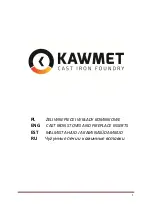
VGZ-011 / 20120105.0
VG810CL SENTRY COAL™
/
Page 15
SERVICE HINTS
CREOSOTE – Formation and Need for
Removal
CAUTION: RISK OF FIRE When coal is burned
slowly, it produces tar and other organic vapors,
which combine with expelled moisture to form
creosote. The creosote vapors condense in the
relatively cool chimney flue of a slow-burning
fire. As a result, creosote residue accumulates
on the flue lining. When ignited this creosote
makes an extremely hot fire.
The chimney connector and chimney should
be inspected at least once every two months
during the heating season to determine if a
creosote buildup has occurred.
If creosote has accumulated (3mm or more)
it should be removed to reduce the risk of a
chimney fire.
Failure to remove creosote may result in ignition
and may cause a house/building fire. Creosote may be
removed using a chimney brush or other commonly
available materials from your local hardware retailer.
Chimney fires burn very hot. If the unit or chimney
connector should glow red, reduce the fire by clos-
ing the inlet air control and immediately call the fire
department.
CAUTION: A CHIMNEY FIRE MAY CAUSE IGNI-
TION OF WALL STUDS OR RAFTERS WHICH
WERE ASSUMED TO BE A SAFE DISTANCE
FROM THE CHIMNEY. IF A CHIMNEY FIRE
HAS OCCURRED, HAVE YOUR CHIMNEY IN-
SPECTED BY A QUALIFIED EXPERT BEFORE
USING AGAIN.
A fire in the firebox may be smothered by pouring
a large quantity of coarse salt, baking soda, or cool
ashes on top of the fire.
Preventing Creosote Buildup
1. Creosote will inevitably form in your chimney and
connector pipe. Following these steps will help
reduce the rate of build up.
2.
Avoid smothering the fire with too much coal.
Too much coal loaded at one time will create
heavy, volitile gas which can coat the chimney
with creosote-forming tar.
3. Burn the stove with the air inlet control wide open
for 10-15 minutes every time fresh coal is loaded
into the stove. Do not load more than ¼ to ½ of the
fuel capacity at one time. Loading too much coal
at once will cause excessive smoke which contains
creosote. Mature fires or coals produce very little
creosote-producing smoke.
Recommendations for burning Anthracite
Coal
1. When burning coal, it is important to maintain a
clean chimney. Inspect chimney connector and
chimney at least twice monthly during the heating
season.
2. Keep the grate clear of ash and cinders.
Use the shaker grate to keep the ashes from build-
ing up in the firebox.
3.
DO NOT operate the stove with the ash door, feed
door, or cabinet door open.
4. Before adding coal, it is necessary to have a good
hot log fire burning. After the log fire is burning, add
small amounts of coal until a bed of coals has been
built up. Anthracite coal burns with a short, blue
flame with the coals having a glowing, red color.
5. Anthracite coal needs a strong draft to burn
efficiently. A draft reading of 0.05 to 0.06 w.c. (water
column) is required to burn anthracite.
The draft wheel located on the feed door,
figure 15, provides a source of secondary air
and should be opened when burning coal. Coal
emits volatile gases when burned and requires a
source of secondary air for complete combustion to
occur. The draft wheel may be adjusted to give the
best performance depending on the particular needs
of the user.
Fig. 15
Feed Door
Draft Wheel
Adjustment








































